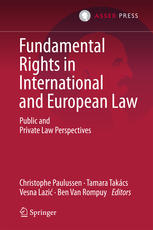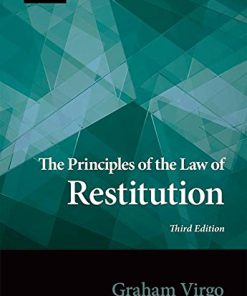The Fundamental Principles of EEA Law 1st Edition by Carl Baudenbacher 9783319832333 3319832336
$50.00 Original price was: $50.00.$25.00Current price is: $25.00.
The Fundamental Principles of EEA Law 1st Edition by Carl Baudenbacher – Ebook PDF Instant Download/Delivery: 3319832336,9783319832333
Full download The Fundamental Principles of EEA Law 1st Edition after payment

Product details:
ISBN 10: 3319832336
ISBN 13: 9783319832333
Author: Carl Baudenbacher
This book features eleven contributions on the fundamental principles of EEA law: legislative and judicial homogeneity, reciprocity, prosperity, priority, authority, loyalty, proportionality, equality, liability and sovereignty. Written by EFTA Court and national judges, high EFTA officials, private practitioners and scholars, it raises awareness of EEA law and provides insights for EEA and EU law practitioners and researchers. It focuses on the principles at the core of EEA law, some of which are common to EU and EEA law, while others have a specific place in EEA law and some ensure consistency between the EEA Agreement and the Treaty on the Functioning of the European Union. It is the only book to focus on the fundamental principles of EEA law.
The Fundamental Principles of EEA Law 1st Table of contents:
1 Introduction
2 The Notion of Homogeneity in the EEA Agreement
3 Homogeneity: A Prerequisite for the Functioning of the Internal Market
4 Decision Making in the EEA
5 Decision Shaping in the EEA
6 A Case in Point: The Financial Supervisory Authorities
7 Reality and Limits of Legislative Homogeneity
8 Homogeneity and Sovereignty
References
Judicial Homogeneity as a Fundamental Principle of the EEA
1 The Wider Picture
1.1 Uniform Interpretation of the Lugano Convention: The Original Story
1.2 Uniform Interpretation of the 2007 Lugano Convention: The New Story
2 The Set-Up of the EEA´s Judiciary
3 Homogeneity and Dispute Settlement Mechanism Under the Agreement
4 The Luxembourg Courts Operating Under EEA Homogeneity Rules
4.1 From One-Way Street Homogeneity to Judicial Dialogue
4.2 The Branches of Homogeneity
4.3 First Mover Scenarios
5 From Snapshot in Time Homogeneity to a Process-Oriented Concept
6 How Has It Worked So Far?
References
Reciprocity
1 Introduction
2 Early Literature
2.1 Starting Point
2.2 Direct Effect and Primacy
2.3 State Liability
2.4 Obligation of the Courts of Last Resort to Refer?
2.5 Legal Nature of the Court´s Preliminary Rulings
3 Early Case-Law
3.1 ECJ Opinion 1/91
3.2 Jurisprudence of the EEA Courts
3.2.1 Direct Effect and Primacy
3.2.2 State Liability and Conform Interpretation
3.2.3 Obligation to Refer?
3.2.4 Legal Nature of the Court´s Preliminary Rulings
3.3 Jurisprudence of National Courts of Last Resort
3.3.1 Direct Effect and Primacy
3.3.2 State Liability
3.3.3 Obligation to Refer?
3.3.4 Legal Nature of the Court´s Preliminary Rulings
4 A New Mantra: `Room for Manoeuvre´
4.1 General
4.2 No Direct Effect and No Primacy, Full Stop
4.3 Freedom of the Courts of Last Resort to Refer
4.4 The Court´s Preliminary Rulings are Only Non-binding Advice
4.5 Criticism of the Sovereigntist Approach
4.6 No `Room for Manoeuvre´ Claims in Iceland and Liechtenstein
5 The 2012-2014 Conflict with the Norwegian Supreme Court
5.1 Systematic Refusal to Refer Between 2002 and 2015
5.2 Irish Bank and Jonsson: A Quasi-Obligation to Refer
5.3 Business as Usual After Irish Bank and Jonsson?
5.4 The STX Case
5.5 From Confrontation to Conciliation
6 Assessment of the Icelandic Appeal System
7 Judicial Independence
8 Conclusions
8.1 General
8.2 Limited Obligation of Courts of Last Resort to Refer
8.3 Legal Nature of the Court´s Preliminary Rulings
References
The Principle of Sincere Cooperation in EEA Law
1 Introduction
2 Treaty Provisions
3 The European Economic Area
4 The Principle of Sincere Cooperation
5 Differences
6 Article 6 of the European Convention of Human Rights
7 Some Case Law of the EFTA Court on Article 3
8 Nullity Under the EEA Agreement
9 Incomplete Compliance with the Principle of Sincere Cooperation
10 The Principle of Sincere Cooperation and Homogeneity
11 Sincere Cooperation and Judicial Dialogue
12 Legal Certainty
13 Implications
References
Sovereignty
1 Introduction
2 Sovereignty and Interpretation
3 More About Sovereignty in International Law and in Domestic Courts
4 EU Law and the EFTA Court
5 The EEA and Four Sovereignties
6 Increasing Pressure on the EEA
References
Prosperity in the EEA
1 Introduction
2 The Concept of Prosperity in the EEA
3 The Benefits of Free Trade
4 Improvement of Working and Living Conditions
5 Ensuring Open and Fair Markets
6 Protection of the Environment
7 Changes Brought About by the Internet and the Digital Economy
8 A Need to Make Citizens More Aware of Their Rights
9 Conclusion
References
Priority
1 Introduction
2 Ways of Shaping the EEA
2.1 Legislative Priorities
2.2 Priorities in Developing the EEA Agreement
2.3 Enforcement Priorities
3 Setting Priorities
3.1 Priorities to What Ends?
3.2 Priorities for Impact
3.3 Priorities for Homogeneity
3.4 Priorities for Communication
4 Conclusion
References
The Authority of the EFTA Court
1 Introduction
2 Historic and Legal Context of Advisory Opinions
2.1 The Absence of a Common Preliminary Reference Procedure
2.2 Procedural Autonomy of the EEA/EFTA States v Homogeneity of EEA Law
2.3 Advisory Opinions´ Role in a Coherent Judicial System
3 No Obligation to Follow an Advisory Opinion?
3.1 Sovereignty and Advisory Opinions
4 No Obligation to Refer?
5 The Authority of EFTA Court´s Case-Law
5.1 The Paradox of Judicial Competence and Stare Decisis
5.2 Treating EFTA Court Case-Law as Binding
5.3 Judicial Homogeneity and EFTA Court Case-Law
6 EFTA Court Case-Law vis-à-vis the ECJ
6.1 Judicial Homogeneity and Its Limits
6.2 The EFTA Court and the Nature of Adjudication
6.3 Adjudicating on EEA Law
6.4 The Problem of Conflicting Case-Law
7 Towards de facto Authority
8 Final Remarks
References
Proportionality as a Fundamental Principle of EEA Law
1 A European Principle
1.1 Origins in Germany
1.2 Emergence Across Europe
1.3 Excursus: Emergence Beyond Europe
1.3.1 National Jurisdictions
1.3.2 International Jurisdictions
1.3.3 Assessment
2 Different Concepts of Proportionality
2.1 General
2.2 ECJ
2.3 ECtHR
2.4 EFTA Court
2.4.1 General
2.4.2 The Legitimate Aim
2.4.3 Suitability
2.4.4 Necessity
2.4.5 Proportionality stricto sensu
2.5 Analysis
3 National Courts in the EFTA Pillar Applying Domestic Law
3.1 Iceland
3.2 Liechtenstein
3.3 Norway
4 National Courts in the EFTA Pillar Applying EEA Law
4.1 Iceland
4.2 Liechtenstein
4.3 Norway
5 Conclusion
References
Equality
1 Equality in the EEA Agreement
1.1 Defining Equality
1.2 Equality in the EEA Agreement
1.3 The Presumption of Equality Between the EU and the EFTA States
2 The Non-Equal System: Regulating the Prohibition Against Market Abuse
2.1 The Fragmented Pillar System: Equality in a Multi-Level EEA
2.2 Equality in the Institutional Set-up: ESMA
3 The Presumption of Equality: The Case Law on Winding Up Financial Undertakings in the EEA
4 Equality: More than a Tool in the Box
References
State Liability in the EEA
1 Introduction
2 The Theoretical Justification for State Liability in the EEA
2.1 A Traditional Treaty or a New Legal Order?
2.2 Effectiveness and Institutional Balance
2.3 Homogeneity
2.4 The Fidelity Clause
3 The Criteria for State Liability in the EEA
3.1 A Sufficiently Serious Breach
3.2 The Provision Must Intend to Confer Rights on Individuals
3.3 A Causal Link Between Breach and Damage
4 The Icesave I Case
5 Conclusion
People also search for The Fundamental Principles of EEA Law 1st :
what are the fundamental principles of international law
fundamental principles of environmental law
the fundamental principles
what is the fundamental law of a country
the fundamental principles of professional ethical behavior are
Tags:
Carl Baudenbacher,Fundamental,Principles,Law
You may also like…
Politics & Philosophy
Business & Economics - Others
Medicine
Fundamental statistical principles for the neurobiologist : a survival guide 1st Edition Scheff
Engineering
Business & Economics
The Art of Judicial Reasoning Festschrift in Honour of Carl Baudenbacher Gunnar Selvik
Jurisprudence & Law
Jurisprudence & Law
Politics & Philosophy - Social Sciences
Politics & Philosophy - Social Sciences












